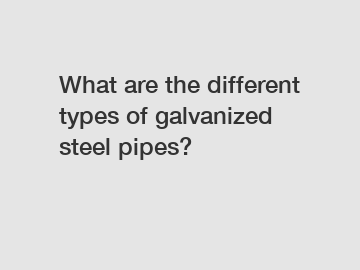What are the different types of galvanized steel pipes?
Steel pipes are a crucial component in numerous industries, playing a pivotal role in transporting fluids and gases. Among the various types of steel pipes available today, galvanized steel pipes have gained significant popularity due to their enhanced durability and resistance to corrosion. In this comprehensive blog, we delve into the different types of galvanized steel pipes, highlighting their unique characteristics and applications. So, let's explore the world of galvanized steel pipes together.
1. Standard or Regular Galvanized Steel Pipes:
These galvanized steel pipes are commonly used in a wide range of applications, including plumbing and construction. The regular galvanization process involves immersing the steel pipes in a zinc bath. As a result, these pipes acquire a protective layer that prevents corrosion and extends their lifespan.

2. Pre-Galvanized Steel Pipes:
Pre-galvanized steel pipes undergo galvanization before being formed into the final shape, making them ideal for various applications. These pipes are often lighter in weight and more affordable compared to their counterparts. They find extensive use in furniture manufacturing, fences, handrails, and electrical conduits.
3. Galvanized Square and Rectangular Steel Pipes:
Designed primarily for structural purposes, galvanized square and rectangular steel pipes offer exceptional strength and durability. Their unique shape allows for better load distribution, making them suitable for frameworks, support columns, and other construction projects. Furthermore, these pipes provide excellent resistance to rust and corrosion, ensuring long-lasting performance.
4. Galvanized Seamless Steel Pipes:
Seamless galvanized steel pipes are manufactured without any welding joints, resulting in a stronger and more reliable product. These pipes are widely used in industries where fluid or gas transport necessitates high pressure, such as oil and gas exploration, chemical processing, and power plants. Their seamless design ensures leak-free performance, reducing the risk of costly maintenance and repair.
5. Hot-Dipped Galvanized Steel Pipes:
Hot-dipped galvanized steel pipes, or HDG pipes, are coated with a layer of zinc through a hot-dipping process. This method provides a thicker zinc coating, making these pipes extremely resistant to corrosion and ensuring longevity. HDG pipes are typically used in water supply systems, underground piping, and highly corrosive environments, where maximum protection against rust is crucial.
6. Galvanized Culvert Pipes:
Designed specifically for drainage purposes, galvanized culvert pipes offer exceptional structural integrity and corrosion resistance. These pipes are commonly used to construct culverts, storm sewers, tunnels, and road crossings. The galvanized coating protects the pipes from external elements, ensuring reliable performance even in harsh weather conditions.
Conclusion:
Galvanized steel pipes come in various types and are employed across numerous industries due to their remarkable durability and corrosion resistance. Whether it is for plumbing, construction, infrastructure development, or industrial applications, choosing the right type of galvanized steel pipe is vital for achieving long-term reliability and cost-effectiveness.
By understanding the different types of galvanized steel pipes and their specific applications, professionals and consumers can make informed decisions to meet their specific project requirements. From standard and pre-galvanized pipes to seamless and hot-dipped options, each type offers unique benefits that cater to diverse industrial needs.
Remember, when investing in galvanized steel pipes, it is essential to choose a reputable supplier known for delivering superior quality products. By doing so, you can ensure that you are receiving pipes that meet industry standards and are built to withstand the test of time.
So, whether you are a construction professional, an industry veteran, or a DIY enthusiast, understanding the different types of galvanized steel pipes will undoubtedly aid you in making informed decisions and achieving successful project outcomes.
Contact us to discuss your requirements of Steel H Post for Highway Guardrail, Steel H Post for Highway Guardrail, w beam highway guardrail. Our experienced sales team can help you identify the options that best suit your needs.


